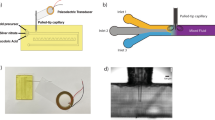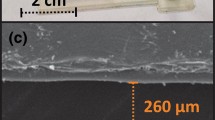Abstract
A low-cost facile synthesis of electronic nanomaterials such as magnetite (Fe3O4), and gold (Au) using polyvinylpyrrolidone (PVP) as a reducing and stabilizing agent in a 3D-printed droplet-based microfluidic device has been demonstrated. The nanomaterial synthesis in terms of obtaining uniformity in size and shape or enhanced magnetism was controlled by applying voltage across the metal electrodes placed just beneath the reagent mixing chamber of the device. The transmission electron microscopy (TEM) characterization showed that application of different alternating current (AC) voltages resulted in different size nanoplate and spherical-shaped Fe3O4 and Au electronic nanomaterials, respectively. A simulation study on accessing the velocity profile of particles within the droplets and transmission probability in AC electric field at different voltages is also demonstrated.







Similar content being viewed by others
Change history
16 August 2022
A Correction to this paper has been published: https://doi.org/10.1007/s41981-022-00233-1
References
Whitesides GM (2006) The origins and the future of microfluidics. Nature 442:368–373
Ren K, Zhou J, Wu H (2013) Materials for Microfluidic Chip Fabrication. Acc Chem Res 46:2396–2406
Ma J, Lee SM-Y, Yi C, Li C-W (2017) Controllable synthesis of functional nanoparticles by microfluidic platforms for biomedical applications – a review. Lab Chip 17:209–226
Liu Y, Jiang X (2017) Why microfluidics? Merits and trends in chemical synthesis. Lab Chip 17:3960–3978
Mornet S, Vasseur S, Grasset F, Duguet E (2004) Magnetic nanoparticle design for medical diagnosis and therapy. J Mater Chem 14:2161–2175
Lu AH, Salabas E, Schüth F (2007) Magnetic nanoparticles: synthesis, protection, functionalization, and application. Angew Chem 119:1242–1266; Angew Chem Int Ed 46:1222–1244
Singh V, Krishnan S (2015) Voltammetric immunosensor assembled on carbon-pyrenyl nanostructures for clinical diagnosis of type of diabetes. Anal Chem 87:2648–2654
Singh V, Krishnan S (2018) Electrochemical and surface plasmon insulin assays on clinical samples. Analyst 143:1544–1555
Singh V (2021) 3D-printed device for synthesis of magnetic and metallic nanoparticles. J Flow Chem 11:135–142
Song H, Chen DL, Ismagilov RF (2006) Reactions in droplets in microfluidic channels. Angew Chem 118:7494–7516; Angew Chem Int Ed 45:7336–7356
Teh SY, Lin R, Hung LH, Lee AP (2008) Droplet microfluidics. Lab Chip 8:198–220
Ziaei-Azad H, Semagina N (2014) Bimetallic catalysts: Requirements for stabilizing PVP removal depend on the surface composition. Appl Catal A 482:327–335
Si R, Zhang YW, You LP, Yan CH (2006) Self-organized monolayer of nanosized ceria colloids stabilized by poly(vinylpyrrolidone). J Phys Chem B 110:5994–6000
Sun Y, Yin Y, Mayers BT, Herricks T, Xia Y (2002) Uniform silver nanowires synthesis by reducing AgNO3 with ethylene glycol in the presence of seeds and poly(vinylpyrrolidone). Chem Mater 14:4736–4745
Wiley B, Sun Y, Xia Y (2007) Synthesis of silver nanostructures with controlled shapes and properties. Acc Chem Res 40:1067–1076
Kim F, Connor S, Song H, Kuykendall T, Yang P (2004) Platonic gold nanocrystals. Angew Chem Int Ed 43:3673–3677
Pastoriza-Santos I, Liz-Marzán LM (2009) N,N-Dimethylformamide as a reaction medium for metal nanoparticle synthesis. Adv Funct Mater 19:679–688
Zheng Y, Cheng Y, Wang Y, Bao F, Zhou L, Wei X, Zhang Y, Zheng Q (2006) Quasicubic alpha-Fe2O3 nanoparticles with excellent catalytic performance. J Phys Chem B 110:3093–3097
Xia Q, Chen X, Zhao K, Liu J (2008) Synthesis and characterizations of polycrystalline walnut-like CdS nanoparticle by solvothermal method with PVP as stabilizer. Mater Chem Phys 111:98–105
Frenz L, El Harrak A, Pauly M, Bégin-Colin S, Griffiths AD, Baret JC (2008) Droplet-based microreactors for the synthesis of magnetic iron oxide nanoparticles. Angew Chem Int Ed 47:6817–6820
Abalde-Cela S, Taladriz-Blanco P, de Oliveira MG, Abell C (2018) Droplet microfluidics for the highly controlled synthesis of branched gold nanoparticles. Sci Rep 8:2440
Massart R (1981) Preparation of aqueous magnetic liquids in alkaline and acidic media. IEEE Trans Magn 17:1247–1248
Zhou Y, Zhu X, Li S (2015) Effect of particle size on magnetic and electric transport properties of La0.67Sr0.33MnO3 coatings. Phys Chem Chem Phys 17:31161–31169
Mamania JB, Gamarra LF, de Souza Brito GE (2014) Synthesis and characterization of Fe3O4 nanoparticles with perspectives in biomedical applications. Mater Res 17:542–549
Zhu Y, Tao S, Chen C, Liu J, Chen M, Shangguan W (2021) A novel approach for evaluating the effect of external electric field on charged particles based on the Lagrangian particle tracking method. Powder Technol 394:92–102
Yi DK, Selvan ST, Lee SS, Papaefthymiou GC, Kundaliya D, Ying JY (2005) Silica-coated nanocomposites of magnetic nanoparticles and quantum dots. J Am Chem Soc 127:4990–4991
Luo X, Du L, Wen Z, Lv W, Zhao F, Jiang X, Peng Y, Sun L, Li Y, Rao J (2015) Remarkably enhanced red–NIR broad spectral absorption via gold nanoparticles: applications for organic photosensitive diodes. Nanoscale 7:14422–14433
Acknowledgements
V.S is grateful to the Department of Science and Technology (DST), Government of India for the financial support under the Women Scientist Scheme (Project Number: SR/WOS-A/ET-46/2018) to carry out this work.
Author information
Authors and Affiliations
Corresponding author
Ethics declarations
The authors declare no conflict interests.
Additional information
Publisher’s Note
Springer Nature remains neutral with regard to jurisdictional claims in published maps and institutional affiliations.
Electronic supplementary material
Below is the link to the electronic supplementary material.
Rights and permissions
About this article
Cite this article
Singh, V., Singh, R. Voltage-driven microfluidic synthesis of magnetite and gold nanomaterials. J Flow Chem 12, 255–261 (2022). https://doi.org/10.1007/s41981-022-00231-3
Received:
Revised:
Accepted:
Published:
Issue Date:
DOI: https://doi.org/10.1007/s41981-022-00231-3




